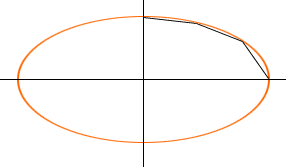I recently sought your advice about a problem that I have been working on for eight years or so concerning a polygon inscribed within an ellipse. I think that I may have confused matters by the way in which I put the question and hope that the enclosed diagram will clear matters up. In the ellipse below I have drawn three chords inscribed within one quadrant ( this would pertain to a twelve sided figure within the whole ellipse). These chords are exactly the same length as each other, for example if the major axis of the ellipse was 360 and the minor axis 240 I have worked out that a twelve sided figure would have sides of 78.2487. However I worked this out empirically with a method that could only be described as gruelling I would be most grateful if you could tell me of a method that would work for any ellipse and any number of sides.

Steven.
Hi Steven,
Gruelling is a good word for a direct computation. There is no simple way to solve your problem directly.
The easiest approach would be to use a computer graphics program that allows one to draw ellipses and circles of desired sizes. I used a program called CINDERELLA that allowed me easily to check that your answer was correct -- but it gives only 3 significant digits. (Incidentally, the name "major axis" refers to one HALF the length of the longest diameter -- your example of an ellipse actually has major axis 180 and minor axis 120.) The program allowed me to draw the ellipse (exact to 3 significant digits). Let X be the vertex on the major axis, with Y on the minor. Draw a circle with center X that meets the ellipse at a point P1 on the ellipse between X and Y. Draw a circle with center P1 that meets the ellipse at X and P2, then a third circle with center P2 that meets the ellipse at P1 and P3. Now move P1 about the ellipse until P3 appears to coincide with Y. Measure the distance from X to P1 to get the approximate answer to your problem for the given ellipse and an inscribed equilateral 12-gon.
You can use a similar process to solve your problem using an computer algebra system such as Mathematica or Maple. You just have the computer give you the position of P3 for increasing values of the radius from X to P1 until P3 gets sufficiently near to Y. You can get your answer to as many significant digits as you wish.
The best method for you to use will depend on the computer resources that are available. All I can tell you for certain is that there is no simple formula that you can use for a direct answer.
Chris